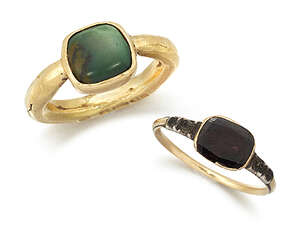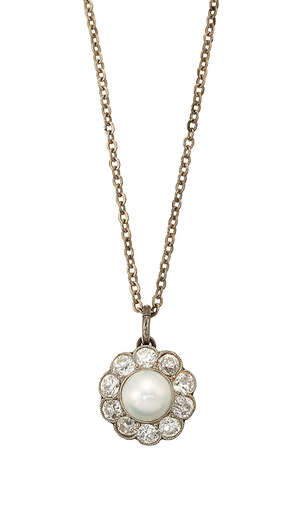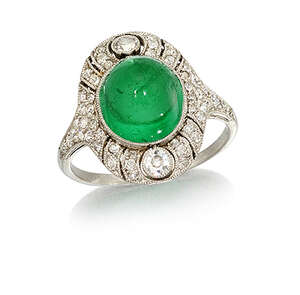Tuesday 19 March 2019
A historically important early 19th century gold ring that was given to Lord Cardigan of...
View MoreLot 223
Description
A historically important early 19th century gold ring that was given to Lord Cardigan of 'Charge of the Light Brigade' fame, the heavy three colour gold broad band ring with chased foliate decoration in relief depicting the rose, thistle and shamrock representing the union of the United Kingdom, the inside of the hoop engraved 'A TRIBUTE OF GRATITUDE To the Rt. Hon'ble the Earl of Cardigan, FROM CAPT. G.T. WETHERED', c. 1830, ring size S
This ring was given or bequeathed by Lord Cardigan to his nephew George Augustus Frederick Louis Curzon-Howe, then Lord Curzon later 2nd Earl Howe, 1821-76, whose mother, Harriet was said to be Cardigan's favourite sister. Lord Howe was twice married, but had only one child (Lady) Harriet Alice. She married the Rev. Henry Neville Sherbrooke 2nd Son of Henry Sherbrooke of Oxton she died in 1875. The ring then passed to the vendor's grandmother Sybil Mary Curzon Sherbrooke, thence by descent.
James Brudenell, 7th Earl of Cardigan, 1797-1868 became a national hero during the Crimean War after leading the Charge of the Light Brigade at the battle of Balaclava on 25th October 1854. He was born on 28th March 1797 at Hambleden, Buckinghamshire and educated at Harrow and Christchurch Oxford. In February 1818 he became a Member of Parliament for Marlborough. During this time he embarked on a Grand Tour, which included visiting Russia and Sweden. In 1837 he inherited the earldom from his father who had died while Brudenell was with his regiment in India, together with the extensive family estates, including Deene Park. It may have been on this occasion that he received the ring from Captain Wethered.
His first marriage was to Elizabeth Tollemache Johnstone in 1826 however this was not a happy union and by 1837 they had separated. He married a second time in 1858 to Adeline de Horsey. This marriage was a greater success however they had no children.
Cardigan's military career began at the age of 22 when he formed his own troop of horse and at the age of 27 he joined the 8th King's Royal Irish Hussars. In 1830 by purchase of commission he had become a lieutenant colonel, he was later appointed to command the 15th Kings Hussars. In 1836 he was given the command of the 11th Hussars.
Cardigans most famous exploit came during the Crimean War, on 25th October 1854 when he was in command of the famous Light Brigade composed of the 4th and 13th Light Dragoons, 17th Lancers, and 8th and 11th Hussars. The commander or the British Army Lord Raglan sent a message to George Bingham 3rd Earl Lucan the overall commander of the cavalry. The order stated ' Lord Raglan wishes the cavalry to advance rapidly to the front follow the enemy and try to prevent the enemy carrying away the guns'. These were guns being removed by Russian forces from redoubts on the south side of a valley. However Lord Lucan interpreted the command to attack the guns that were at the end of the valley and with the persuasion of the messenger, a young officer, Captain Louis Edward Nolan, Lucan commanded Cardigan to send his 670 troopers to attack these guns, that were about a mile away. The result was a disaster for the Light Brigade having to charge over 50 Russian guns and cost the lives of 107 men including Captain Nolan who was one of the first to be killed. Cardigan remained unscathed and after passing through the guns made his way back to his lines. He returned to England later that year arriving at Folkestone in January 1855. He was later made Knight Commander of the Order of the Bath and appointed Colonel of the regiment of the 11th Hussars. He retired in 1866 and died on March 28th 1868 ironically from injuries caused from falling from his horse.
A painting by R. Buckner shows Lord Cardigan wearing the ring. Sadly we have been unable to ascertain the relationship or biographical details of Captain Wethered.
Fees & VAT
Buyer's Premium
The buyer shall pay the hammer price together with a premium thereon of 26% up to £20,000 (31.2% inclusive of VAT), 25% from £20,001 - £500,000 (30% inclusive of VAT), 20% from £500,001 thereafter (24% inclusive of VAT). The premium price is subject to VAT at the standard rate.
VAT
VAT is not charged on the hammer price unless it is stated that there is 'VAT applicable on the hammer price at the end of the description. Buyer's premium is subject to VAT.(ARR) - ARTIST'S RESALE RIGHT
Qualifying living artists and the descendants of artists deceased within the last 70 years are entitled to receive a re-sale royalty each time their work is bought through an auction house or art market professional.
It applies to lots with hammer value over £1,000 as follows:
0 to £50,000 - 4%
£50,000.01 to £200,000 - 3%
£200,000.01 to £350,000 - 1%
£350,000.01 to £500,000 - 0.5%
Exceeding £500,000 - 0.25%
ARR is capped at £12,500
Please note ARR is calculated in euros. Auctioneers will apply current exchange rates.
Export of goods
Buyers intending to export goods should ascertain whether an export licence is required before bidding. Export licences are issued by Arts Council England and application forms can be obtained from its Export Licensing Unit. Details can be found on the ACE website www.artscouncil.org.uk or by phoning ACE on 020 7973 5188. The need for import licences varies from country to country and you should acquaint yourself with all relevant local requirements and provisions before bidding. The refusal of any such licences shall not permit the cancelling of any sale nor allow any delay in making full payment for the lot.
Own a similar item?
Request a ValuationReceive alerts about similar lots
Get StartedContinue Browsing
LOT 224
An early 19th century gold, diamond and enamel mourning ring commemorating the death of ...
Estimate: £2000 - £4000
LOT 225
An early 19th century gold, mourning ring, the oval bezel with glazed locket compartment...
Estimate: £150 - £200
LOT 226
A Victorian 18ct. gold and diamond mourning ring, the band set in the centre with a...
Estimate: £200 - £300
LOT 227
An early 19th century gold, garnet and diamond ring, and an 18ct gold turquoise ring,
Estimate: £250 - £350
LOT 228
An 18ct. gold ring set with a Roman cornelian intaglio, the oval intaglio engraved to...
Estimate: £200 - £300
LOT 229
A 19th century gold-mounted coral cameo ring, the oval coral, corallium rubrum, carved to...
Estimate: £500 - £700
LOT 230
A late 19th century gold mounted glass intaglio ring, the oval brown glass intaglio...
Estimate: £200 - £300
LOT 231
A platinum, diamond single stone ring, the claw-set single old-mine-cut diamond weighing...
Estimate: £400 - £600
LOT 232
A pearl and diamond cluster pendant, the central bouton pearl with old-brilliant-cut...
Estimate: £400 - £600
LOT 233
A platinum, emerald and diamond bracelet, the central millegrain-set single cabochon...
Estimate: £3000 - £5000
LOT 234
A Belle Epoque, platinum, cabochon emerald and diamond ring, c. 1915, the single...
Estimate: £3000 - £5000
LOT 235
A Belle Epoque platinum, emerald and diamond brooch, the central rectangular-cut cornered...
Estimate: £3000 - £5000
LOT 236
A Russian, platinum, gold, sapphire and diamond brooch, designed as a rose-cut...
Estimate: £5000 - £8000
LOT 237
A platinum, diamond, pearl and onyx brooch, by Boucheron, the circular panel with central...
Estimate: £2500 - £3500
 Newsletter Signup
Newsletter Signup
 Keyword Alerts
Keyword Alerts
Would you like to receive personalised keyword alerts when new catalogues go live. If so, please indicate these below
Set a password to save your keyword alerts
Passwords are a minimum of 7 characters and must include an upper case letter, a lower case letter, a number and a special character (e.g., !@#$%^&*).
























